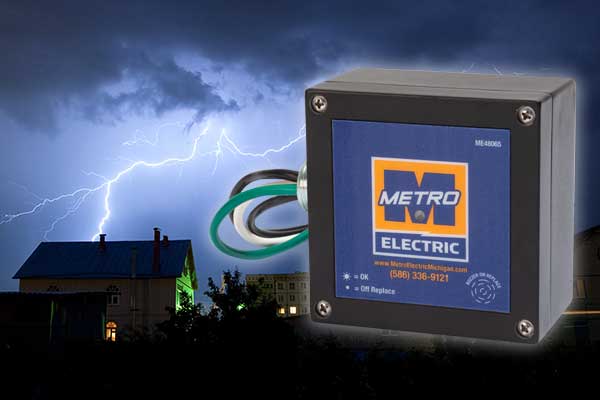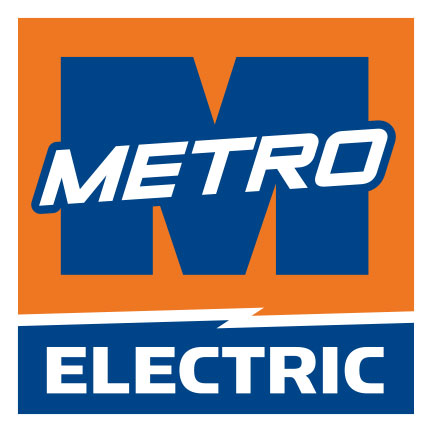Surge Suppression
Protect your home from a power surge!
Shield your home and all its belongings from an electrical surge by installing a whole-house surge suppression system from Metro Electric.
In our homes, we like to have nice things. Nice things can also be costly and should be completely protected. Here in SE Michigan, we can have storms that affect our utility power with spikes and surges. Metro Electric can install a whole-house surge suppressor helping safeguard your home and its electrical system from costly damage. We can also provide protection to your phone lines, cable, and satellite TV.

Power surges pose a threat to all household devices plugged into the electrical grid. They can follow any wire in the home, and low-cost multi-outlet Surge Suppressors can’t always prevent devices from damage. True whole-home protection only comes from hiring an electrician to hard-wire a Surge Suppressor into the home’s main electrical panel.
What Are Power Surges?
Power surges are sudden increases in voltage that exceed 120 volts. When this happens, it can cause the wiring in any affected devices or appliances to overheat. Since modern homes contain many expensive appliances and electronic devices, homeowners need to take preventative action to stop this kind of damage before it occurs.
Even a slight power surge can place strain on affected devices and compromise their performance. A serious power surge can completely destroy them. Affected appliances can include:
- computers
- televisions
- phones
- stereos
- microwaves
- other small appliances
- any electronic devices that have circuitry or microchips.

What Causes Power Surges?
Heavy-duty electrical devices are the primary culprits behind power surges. Large appliances like refrigerators, air conditioning units, and clothes dryers require substantial amounts of electricity to turn motors and compressors on and off. This creates a heavy electrical demand that disrupts the flow of voltage in the rest of the electrical system. Other causes of power surges include faulty wiring, downed power lines, problems with municipal transformers, lines and other components, and lightning strikes.
While some of the causes of power surges, such as excessive electrical draw from large appliances, can be protected against, others are entirely outside of homeowners’ control. That’s where whole-home surge protectors come in.
How Do Whole-Home Surge Protectors Work?
When most Romeo, Michigan, homeowners think about surge protectors, they immediately conjure up an image of a small power strip with multiple devices plugged into it. These small devices work by automatically redirecting any excess electricity into metal oxide varistors (MOVs) found inside the power strip. They only offer limited protection, though, and they must be replaced each time a power surge occurs. In some cases, homeowners may not even realize that they’ve experienced a power surge that has damaged their power strips. In others, they just don’t think to replace them after the surge. When this happens, their devices are effectively left without any sort of protection.
Whole-home surge protectors operate similarly to power strips, but on a much larger scale. They’re able to protect all devices and appliances receiving power through the home’s electrical panel and are designed to withstand multiple power surges. In most cases, they can protect sensitive electronics from surge damage for years without needing to be replaced.
What to Expect During the Installation
Whole-home surge protectors must be installed by licensed electricians. The devices are designed to be wired directly into the home’s electrical box. Improper installation can render them useless and can even cause a risk of electrical damage. It takes most electricians around two hours to install whole-home surge protectors.
What to Expect During Normal Operation
While there’s no such thing as 100% protection against surge damage, whole-home surge protectors can keep all the home’s devices fully protected during most types of power surges. Major power surges that occur as a result of direct lightning strikes can still cause damage. Whole-home surge protectors can reduce the resulting damage even if they are not able to fully protect all devices.
Additional Safety Tips
Homeowners who want to go the extra mile can take two additional steps to prevent damage to their electronics. First, they can combine single-outlet surge protectors with whole-house surge protectors for a two-tiered approach to keeping devices safe. Whole-home surge protectors feature a clamping voltage of 600 to 660 volts. Most household devices operate within a range of 106 to 127 volts. Adding an extra level of protection for sensitive electronics by installing individual outlet power strips, which have lower clamping voltages, in addition to whole-home surge protectors is a great way to keep devices safe.
Homeowners who know that their houses are at increased risk of experiencing power surges can also unplug their electrical devices when they are not in use. This is the best way to ensure no damage occurs to sensitive electronics and appliances should a major surge occur.
The Bottom Line
Want to add an extra level of protection against power surges? It’s time to call a Professional Electrician to schedule a whole-home surge protector installation. Metro Electric can help. Their technicians have decades of combined experience working with this technology, and all employees receive regular on-the-job training to ensure that they are kept up-to-date about industry standards.
